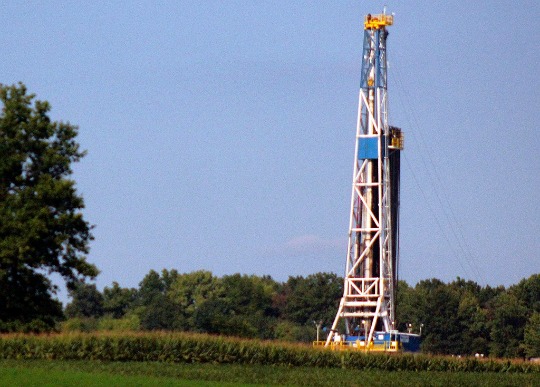http://www.commondreams.org/headline/2014/04/15-4
Published on Tuesday, April 15, 2014
New report suggests highly potent greenhouse gas far more prevalent in gas production than previously thought
– Jacob Chamberlain, staff writer

Marcellus Shale Gas Well, Lawrence County, Penn. (Flickr / WCN247 / Creative Commons license)
Natural gas drilling is emitting far higher levels of methane into the atmosphere than federal regulators at the Environmental Protection Agency have said, according to the findings of a new study released Monday.
“We identified a significant regional flux of methane over a large area of shale gas wells in southwestern Pennsylvania in the Marcellus formation and further identified several pads with high methane emissions,” said the report, conducted by a team of scientists led by Purdue University and published in the Proceedings of the National Academy of Sciences.
While past EPA studies have said gas well sites emit as little as between 0.04 and 0.30 grams of methane per second, this new study found numbers between 100 to 1,000 times higher than what the EPA has calculated, with levels closer to 34 grams of methane per second at some of the Pennsylvania sites. Methane is up to 30 times stronger than carbon dioxide as a greenhouse gas.
Of particular curiosity for the research team was the fact that the highest levels of methane were coming from well sites that were being preliminarily drilled for production, but had not yet gone through the controversial gas production process known as fracking.
“The methane emissions from the gas wells … are surprisingly high considering that all of these wells were still being drilled, had not yet been hydraulically fractured, and were not yet in production,” the paper reports.
“Methane plumes might be the result of drilling through coal beds,” said the study, “which are known to release large amounts of methane when mined. Fracking sites in the Marcellus Shale formation are commonly located over coal beds.”
As the Los Angeles Times reports, Monday’s findings add to “a growing body of research that suggests the EPA is gravely underestimating methane emissions from oil and gas operations.” The EPA’s research has largely been subject to the whims of the industry, the researchers noted, which has a say over where and when the agency has access to drilling sites. Monday’s Purdue report, on the other hand, used a plane equipped with technology to measure greenhouse gas levels in the air above the sites.
Meanwhile, the EPA released its own new set of methane information on Tuesday with a series of technical white papers detailing the sources of methane emissions in the oil and gas industry. The agency also opened a public comment period, which will be used—alongside peer reviewed input—”to determine how to best pursue additional reductions from these sources.”
The EPA said the white papers, which detail five main sources of methane leakage in the fossil fuel industry—natural gas compressors, hydraulic fracturing for oil, natural gas production, removing liquids in gas wells and pneumatic devices used in the gas industry—are designed to help the agency “solidify [its] understanding of certain sources of methane and volatile organic compound (VOC) emissions in the oil and natural gas industry.”
______________________